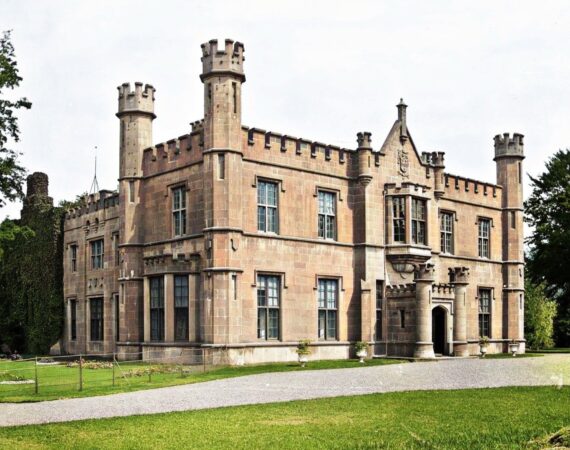Camlin Castle, Ballyshannon, Co. Donegal
A grand Tudor Revival castle was blown to bits in the 1940s for a hydro-electric scheme, only for engineers to discover the waters would never have reached it anyway.
Camlin Castle, Ballyshannon, Co. Donegal
Standing on the road between Ballyshannon and Belleek, an impressive castellated gateway marks the entrance to what was once Camlin Castle. The gateway, complete with its fairy-tale tower and Gothic battlements, is all that remains of a three-century family seat that fell victim to one of Ireland’s greatest architectural blunders.
The Tredennick family first came to Camlin around 1718, when William Tredennick secured a lease from William ‘Speaker’ Conolly, who’d recently purchased the local estates from Lord Folliott. Over the generations, the Tredennicks became influential landlords, acquiring vast tracts of land on both sides of the River Erne and building several grand houses including Templenew, Fort William, and Cherrymount. By all accounts, they were considered benevolent landlords who contributed significantly to the local area.
The castle itself underwent a major transformation in 1838, when John A. Tredennick commissioned the renowned architect John Benjamin Keane to rebuild the house in the fashionable Tudor Revival style. Keane, who was better known for his church designs, incorporated parts of the earlier 17th-century structure into his new creation. At the same time, he designed the theatrical gateway that still stands today—a soaring flag tower with machicolated parapets and Irish-style crenellations that wouldn’t look out of place in a Gothic novel.
The Fateful Decision
When the ESB (Electricity Supply Board) began developing the Erne Hydro-Electric Scheme in the 1940s, planners assumed Camlin Castle would be submerged beneath the waters of the new Assaroe Lake. Rather than wait to see the actual water levels, the decision was made to demolish the castle entirely. Dramatic footage from the time shows the building being blown up, sending three centuries of history skyward in clouds of dust and debris.
The scheme brought significant changes to the region. The Erne river was widened and deepened, and two hydro-electric stations were built at Cliff and Ballyshannon. The development provided well-paid employment for South Donegal during difficult economic times, and the constant sound of the river was replaced by the industrial hum of turbines—much like today’s wind farms, as local historian Joe O’Loughlin notes, though with far more permanent consequences for the landscape.
The Bitter Irony
Here’s the tragedy: the waters never came. When Assaroe Lake filled, its levels fell well short of the castle site. The foundations of Camlin Castle remain visible today, a monument to hasty decision-making. The house could have been saved, making its destruction one of the more regrettable losses in Ireland’s architectural heritage.
The last Tredennick to live at Camlin was Charles Joseph Haydon Tredennick, who left in 1929 after the estate was sold to the Land Commission around 1900. The family’s influence extended beyond the castle walls; Major General James Richard Knox Tredennick served with distinction, while his brother, the Reverend George Nesbitt Tredennick, was Church of Ireland Rector of Kilbarron parish from 1839 to 1877.
What Remains
Today, visitors can still admire the castellated gateway designed by Keane. Built from dressed and snecked ashlar stone, it features a Tudor-arched carriage entrance flanked by screen walls and a now-ruined gate lodge. The circular flag tower, with its blind loopholes and gun opening motifs, rises dramatically against the sky. Though the Saxon-style metal gates are replacements, the structure remains remarkably intact.
The gateway stands as both a memorial to what was lost and a reminder of how progress, when pursued without patience or proper planning, can destroy irreplaceable heritage. Every stone in its walls tells the story of Camlin Castle, a house that survived three centuries of Irish history only to be destroyed for flood waters that never came.
Good to Know
Location: On the R230 between Ballyshannon and Belleek, County Donegal
Parking: Limited roadside parking available near the gateway
Access: The gateway can be viewed from the road; the castle foundations are on private land
Nearby Attractions: Cliff Power Station, Teigh Tunney Graveyard (dating back 400 years), Assaroe Abbey ruins in Ballyshannon
Best Time to Visit: The gateway is particularly atmospheric in evening light when shadows play across the castellations
Historical Note: The site is also near Teigh Tunney, location of a famous 1590s battle between Hugh O'Neill and Henry Bagenal






